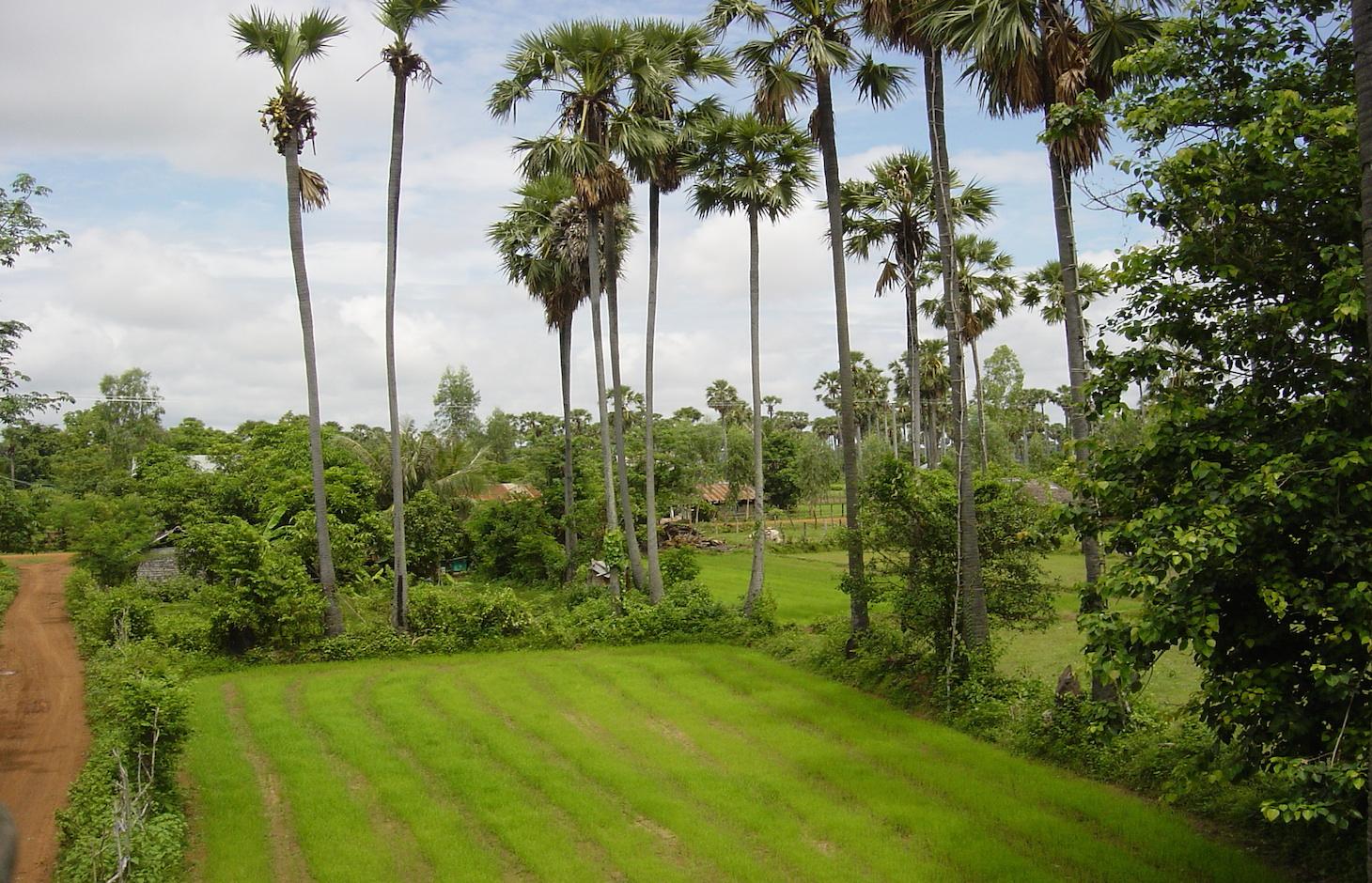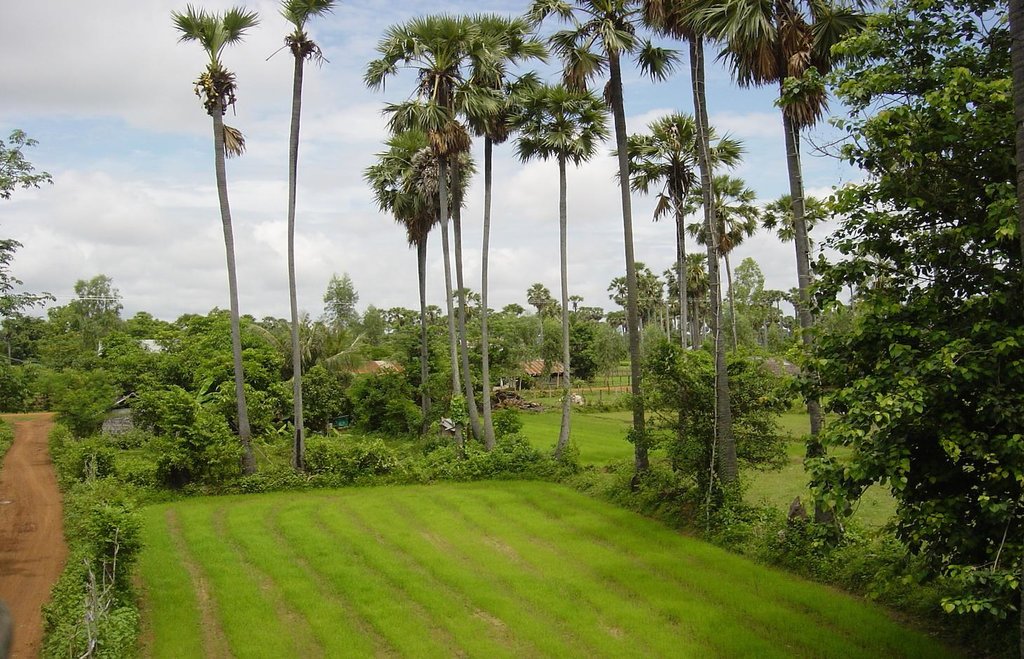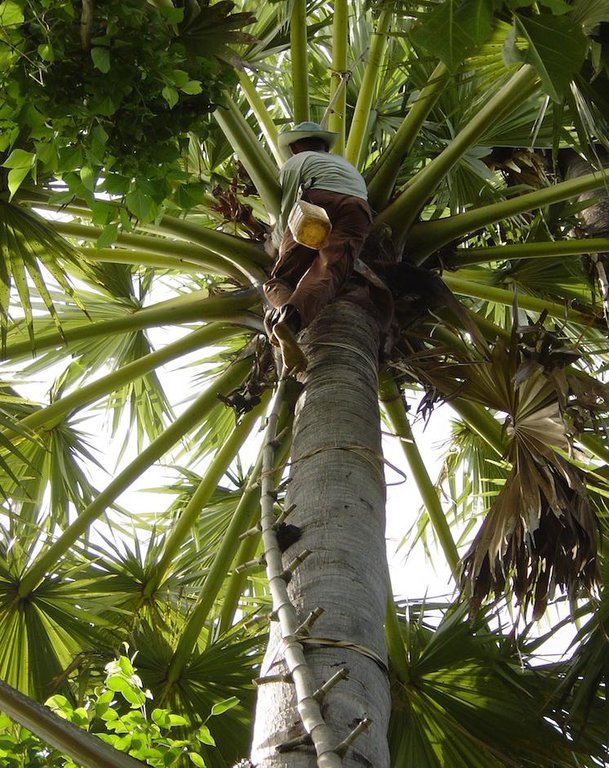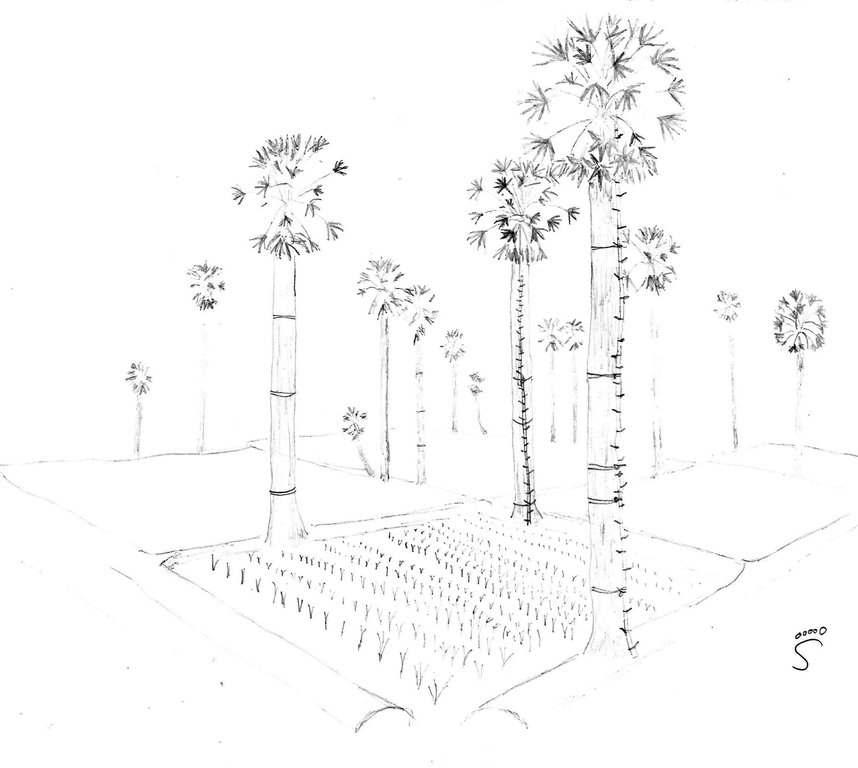Multipurpose use of sugar palm grown on rice field dykes. [Cambodge]
- Création :
- Mise à jour :
- Compilateur : Stefan Graf
- Rédacteur : –
- Examinateurs : Deborah Niggli, Alexandra Gavilano
ការប្រើប្រាស់ដើមតោ្នតដែលដំានៅតាមភ្លឺស្រែ (Khmer)
technologies_1629 - Cambodge
Voir les sections
Développer tout Réduire tout1. Informations générales
1.2 Coordonnées des personnes-ressources et des institutions impliquées dans l'évaluation et la documentation de la Technologie
Spécialiste GDT:
Khun Lean Hak
SOFDEC/LAREC, www.sofdec.com
1.3 Conditions relatives à l'utilisation par WOCAT des données documentées
Le compilateur et la(les) personne(s) ressource(s) acceptent les conditions relatives à l'utilisation par WOCAT des données documentées:
Oui
1.4 Déclaration sur la durabilité de la Technologie décrite
Est-ce que la Technologie décrite ici pose problème par rapport à la dégradation des terres, de telle sorte qu'elle ne peut pas être déclarée comme étant une technologie de gestion durable des terres?
Non
2. Description de la Technologie de GDT
2.1 Courte description de la Technologie
Définition de la Technologie:
Sugar palms growing on the dykes along the rice fields are used as source of income and have different effects on the growing of the rice, like reducing the wind speed and thus the evaporation and wind erosion.
2.2 Description détaillée de la Technologie
Description:
The sugar palm (Borassus flabellifer ) is the national tree of Cambodia, it is well adapted to the local natural environment and there is a long tradition to grow sugar palms. Therefore, only a negligible workload is required for both the establishment (fruits falling down from the already existing trees will grow) and the maintenance of the trees. As the sugar palm is resistant to waterlogging and floods (even in flooded areas in the floodplains), and it grows well at low pH, it is planted/grown on the rice field dykes and around the houses. The trees which are growing around the paddy fields have some positive effects on both soil and rice, as they slow down the wind and thus reduce evaporation and wind erosion. They also attract wildlife, and thus allow the establishment of other vegetation. The trees also have a purifying effect on the groundwater, and cycle the nutrients which are otherwise lost in the groundwater. The sugar palms and their products can be used in manifold ways: the leaves for wickerwork and roofs; the stems as fences, for ropes and strings; the fruits as food, fodder and to make straw palatable for cattle; the sap as fodder, to make wine, sugar, and vinegar; and the trunk as construction wood – these are only some of its uses. They reduce the risk of a complete crop failure, as their products are not subject to weather fluctuations.
After the collectivization of land during the civil war (1975-1979), the land and the trees were newly distributed to the people according to the size of the household. The ownership of the land and of the trees was not related. Until today, the trees can be growing on someone’s land, but can be sold or rented to somebody else who harvests its products.
The main reason to plant sugar palms in this area is the sap collection. In order to collect the sap, firstly bamboo ladders are tied to the sugar palm trees. In the dry season, the tapper climbs up the trees to collect the sap. The male or female inflorescence is crushed with a special tool and a piece of it sliced off. Bottles are hanged beneath the cut part, and the sap will flow into these bottles. The crushing and slicing is repeated twice a day, so the amount of collected sap can be optimized. Most of the sap is cooked on a fire and made into syrup, and if there is too much sap, it is fermented and sold as palm wine.
The fruits that fall down on the rice fields are thrown on the dykes, where they grow. The seedlings tolerate some cattle grazing, as long as only the leaves and not the bud are eaten.
The analysed area is flat (slope < 2%), with a tropical climate (dry season from November to May and wet season from June to October), and the soils are mostly sandy or loamy. The soil has a low fertility, contains little organic matter, and acidifies. The area has been deforested a long time ago, and the groundwater table is rather high (1-2 m during the dry season, on the surface during wet season). Due to climate change, farmers notice more erratic rainfalls, temperature rises and more recurrent droughts. Rice is the predominant crop grown in the area, since it serves as staple food (mix subsistence and commercial activities).
The increasing migration rate (the young generation leaves the villages to work in the cities, garment industry or abroad) results in a decrease of available labour force in the area which has detrimental effects on the agricultural activities. Furthermore, the civil war in the 1970s (Khmer Rouge) led to the loss of agricultural knowledge which different NGOs try to re-establish.
2.3 Photos de la Technologie
2.5 Pays/ région/ lieux où la Technologie a été appliquée et qui sont couverts par cette évaluation
Pays:
Cambodge
Région/ Etat/ Province:
Kampong Chhnang
Autres spécifications du lieu:
Rolear Bier / Thnorng Kombot
Spécifiez la diffusion de la Technologie:
- répartie uniformément sur une zone
S'il n'existe pas d'informations exactes sur la superficie, indiquez les limites approximatives de la zone couverte:
- 10-100 km2
Commentaires:
This technology is applied in most parts of Cambodia. Almost everywhere there are some sugar palms growing along the rice fields, but not in this density. The area mentioned is the area in the district where the technology is applied.
2.6 Date de mise en œuvre de la Technologie
Si l'année précise est inconnue, indiquez la date approximative: :
- il y a plus de 50 ans (technologie traditionnelle)
2.7 Introduction de la Technologie
Spécifiez comment la Technologie a été introduite: :
- dans le cadre d'un système traditionnel (> 50 ans)
Commentaires (type de projet, etc.) :
It is a traditional tree in Cambodia, with historical use. Its introduction on the rice field dykes is unknown.
3. Classification de la Technologie de GDT
3.1 Principal(aux) objectif(s) de la Technologie
- améliorer la production
- réduire, prévenir, restaurer les terres dégradées
3.2 Type(s) actuel(s) d'utilisation des terres, là où la Technologie est appliquée
Les divers types d'utilisation des terres au sein du même unité de terrain: :
Oui
Précisez l'utilisation mixte des terres (cultures/ pâturages/ arbres):
- Agroforesterie

Terres cultivées
- Cultures annuelles
- Plantations d’arbres ou de buissons
- rice
- sugar palm
Nombre de période de croissance par an: :
- 1
Précisez:
Longest growing period in days: 210, Longest growing period from month to month: June-December
Commentaires:
Major land use problems (compiler’s opinion): Lack of organic matter, lack of water retention in soil, irregularity of rainfall, low soil fertility (sandy soil), monocultures, bare soil during dry season, ploughing, wind erosion and dust storms.
Major land use problems (land users’ perception): Soil fertility is low, rainfall is not secured in the beginning of the rainy season.
3.4 Approvisionnement en eau
Approvisionnement en eau des terres sur lesquelles est appliquée la Technologie:
- pluvial
3.5 Groupe de GDT auquel appartient la Technologie
- agroforesterie
- brise-vent/ plantations abris
3.6 Mesures de GDT constituant la Technologie

pratiques végétales
- V1: Couverture d’arbres et d’arbustes
Commentaires:
Type of vegetative measures: aligned: -along boundary
3.7 Principaux types de dégradation des terres traités par la Technologie

érosion éolienne des sols
- Et: perte de la couche superficielle des sols (couche arable)

dégradation chimique des sols
- Cn: baisse de la fertilité des sols et réduction du niveau de matière organique (non causée par l’érosion)

dégradation biologique
- Bh: perte d’habitats
- Bs: baisse de la qualité et de la composition/ diversité des espèces
Commentaires:
Main causes of degradation: soil management (Ploughing of the soil. Depending on the rainfall, sometimes the land is left bare for several days or weeks.), crop management (annual, perennial, tree/shrub) (Mainly rice is grown in monocultures.), over-exploitation of vegetation for domestic use (Straw is usually removed from the fields.), labour availability (Labour availability is low due to high migration rates (garment industry, drift to the cities, working abroad).)
Secondary causes of degradation: change in temperature (More hot days, the soil dries out faster.), droughts, education, access to knowledge and support services (Little knowledge about soil conservation.), war and conflicts (During the Khmer Rouge regime, a lot of agricultural knowledge got lost.)
3.8 Prévention, réduction de la dégradation ou réhabilitation des terres dégradées
Spécifiez l'objectif de la Technologie au regard de la dégradation des terres:
- prévenir la dégradation des terres
4. Spécifications techniques, activités, intrants et coûts de mise en œuvre
4.1 Dessin technique de la Technologie
Spécifications techniques (associées au dessin technique):
Sugar palms (Borassus flabellifer) with bamboo ladders growing on the dikes around the rice fields.
Kampong Chhnang
Date: 2014
Technical knowledge required for field staff / advisors: low
Technical knowledge required for land users: low (They grow almost by themselves, as the fallen fruits are just thrown on the dykes as only management.)
Main technical functions: reduction in wind speed
Secondary technical functions: increase in nutrient availability (supply, recycling,…), increase / maintain water stored in soil
Aligned: -along boundary
Vegetative material: F : fruit trees / shrubs
Number of plants per (ha): 63
Vertical interval between rows / strips / blocks (m): 20
Vertical interval within rows / strips / blocks (m): 10
Fruit trees / shrubs species: Mostly naturally regenerated, but seeds are thrown on the dykes when they fall into the rice fields.
Auteur:
Stefan Graf, Switzerland
4.2 Informations générales sur le calcul des intrants et des coûts
Indiquez le coût salarial moyen de la main d'œuvre par jour:
5.00
4.3 Activités de mise en place/ d'établissement
| Activité | Calendrier des activités (saisonnier) | |
|---|---|---|
| 1. | Build a stove and buy pans to cook the sap into sugar. |
4.4 Coûts et intrants nécessaires à la mise en place
| Spécifiez les intrants | Unité | Quantité | Coûts par unité | Coût total par intrant | % des coût supporté par les exploitants des terres | |
|---|---|---|---|---|---|---|
| Main d'œuvre | Labour | ha | 1,0 | 10,0 | 10,0 | 100,0 |
| Equipements | machine use | ha | 1,0 | 25,0 | 25,0 | 100,0 |
| Coût total de mise en place de la Technologie | 35,0 | |||||
| Coût total de mise en place de la Technologie en dollars américains (USD) | 35,0 | |||||
4.5 Activités d'entretien/ récurrentes
| Activité | Calendrier/ fréquence | |
|---|---|---|
| 1. | Tie the bamboo ladders to the tree | |
| 2. | Collect the sap by pressing the inflorescence, cutting a slice off and putting a bottle underneath. | December-April, twice a day |
| 3. | Cook the sap to make sugar | Once or twice a day |
| 4. | Ferment the juice to make palm wine | If there's too much juice. |
4.6 Coûts et intrants nécessaires aux activités d'entretien/ récurrentes (par an)
| Spécifiez les intrants | Unité | Quantité | Coûts par unité | Coût total par intrant | % des coût supporté par les exploitants des terres | |
|---|---|---|---|---|---|---|
| Main d'œuvre | Labour | ha | 1,0 | 3221,0 | 3221,0 | 100,0 |
| Matériaux de construction | Firewood | ha | 1,0 | 357,0 | 357,0 | 100,0 |
| Matériaux de construction | Bamboo and rattan | ha | 1,0 | 471,0 | 471,0 | 100,0 |
| Coût total d'entretien de la Technologie | 4049,0 | |||||
| Coût total d'entretien de la Technologie en dollars américains (USD) | 4049,0 | |||||
Commentaires:
Machinery/ tools: Self-made crusher to induce a higher sap flow.
The costs were calculated with 44 trees (one unit), transformed into 62 trees per ha. The assessed farmer owns 0.35 ha of rice fields, with 22 trees on the dykes, but he bought additional trees on nearby dykes. The whole family is involved in the process.
The maintenance costs indicated above are that high because labour was calculated for each step. However, a big part of the work is done voluntarly by local land users and are not payed.
4.7 Facteurs les plus importants affectant les coûts
Décrivez les facteurs les plus importants affectant les coûts :
The factors affecting the costs are mainly the inputs (firewood, work to cook the sap to sugar) used to transform the sap into saleable products. They are not necessary to benefit from the positive effects of sugar palms on the microclimate and soil. To implement sugar palms on the rice field dikes the costs are negligible.
5. Environnement naturel et humain
5.1 Climat
Précipitations annuelles
- < 250 mm
- 251-500 mm
- 501-750 mm
- 751-1000 mm
- 1001-1500 mm
- 1501-2000 mm
- 2001-3000 mm
- 3001-4000 mm
- > 4000 mm
Spécifications/ commentaires sur les précipitations:
1486.45 mm 2013 in Kampong Chhnang
Zone agro-climatique
- subhumide
Thermal climate class: tropics. 27-35°C
5.2 Topographie
Pentes moyennes:
- plat (0-2 %)
- faible (3-5%)
- modéré (6-10%)
- onduleux (11-15%)
- vallonné (16-30%)
- raide (31-60%)
- très raide (>60%)
Reliefs:
- plateaux/ plaines
- crêtes
- flancs/ pentes de montagne
- flancs/ pentes de colline
- piémonts/ glacis (bas de pente)
- fonds de vallée/bas-fonds
Zones altitudinales:
- 0-100 m
- 101-500 m
- 501-1000 m
- 1001-1500 m
- 1501-2000 m
- 2001-2500 m
- 2501-3000 m
- 3001-4000 m
- > 4000 m
5.3 Sols
Profondeur moyenne du sol:
- très superficiel (0-20 cm)
- superficiel (21-50 cm)
- modérément profond (51-80 cm)
- profond (81-120 cm)
- très profond (>120 cm)
Texture du sol (de la couche arable):
- grossier/ léger (sablonneux)
- moyen (limoneux)
Matière organique de la couche arable:
- moyen (1-3%)
- faible (<1%)
5.4 Disponibilité et qualité de l'eau
Profondeur estimée de l’eau dans le sol:
< 5 m
Disponibilité de l’eau de surface:
faible/ absente
Qualité de l’eau (non traitée):
faiblement potable (traitement nécessaire)
Commentaires et précisions supplémentaires sur la qualité et la quantité d'eau:
Ground water table: during dry season
Availability of surface water: during dry season
Drinking water: People use it for drinking after filtering or boiling.
5.5 Biodiversité
Diversité des espèces:
- moyenne
5.6 Caractéristiques des exploitants des terres appliquant la Technologie
Orientation du système de production:
- exploitation mixte (de subsistance/ commerciale)
Revenus hors exploitation:
- 10-50% de tous les revenus
Niveau relatif de richesse:
- pauvre
- moyen
Individus ou groupes:
- individu/ ménage
Niveau de mécanisation:
- travail manuel
Genre:
- femmes
- hommes
Indiquez toute autre caractéristique pertinente des exploitants des terres:
Land users applying the Technology are mainly common / average land users
Population density: 50-100 persons/km2
Annual population growth: 0.5% - 1%
Off-farm income specification: Handicraft, remittances, and factory work.
5.7 Superficie moyenne des terres utilisées par les exploitants des terres appliquant la Technologie
- < 0,5 ha
- 0,5-1 ha
- 1-2 ha
- 2-5 ha
- 5-15 ha
- 15-50 ha
- 50-100 ha
- 100-500 ha
- 500-1 000 ha
- 1 000-10 000 ha
- > 10 000 ha
Cette superficie est-elle considérée comme de petite, moyenne ou grande dimension (en se référant au contexte local)?
- petite dimension
5.8 Propriété foncière, droits d’utilisation des terres et de l'eau
Propriété foncière:
- communauté/ village
- individu, sans titre de propriété
Droits d’utilisation des terres:
- communautaire (organisé)
- individuel
Droits d’utilisation de l’eau:
- accès libre (non organisé)
Commentaires:
Land users have a title that is not recognized by the state. The trees sold by farmers to neighbours have a paper signed by the village chief to certify the ownership.
5.9 Accès aux services et aux infrastructures
santé:
- pauvre
- modéré
- bonne
éducation:
- pauvre
- modéré
- bonne
assistance technique:
- pauvre
- modéré
- bonne
emploi (par ex. hors exploitation):
- pauvre
- modéré
- bonne
marchés:
- pauvre
- modéré
- bonne
énergie:
- pauvre
- modéré
- bonne
routes et transports:
- pauvre
- modéré
- bonne
eau potable et assainissement:
- pauvre
- modéré
- bonne
services financiers:
- pauvre
- modéré
- bonne
6. Impacts et conclusions
6.1 Impacts sur site que la Technologie a montrés
Impacts socio-économiques
Production
production agricole
Commentaires/ spécifiez:
Leaves fall on the fields, but if they are removed the adverse effect is negligible.
production de bois
Commentaires/ spécifiez:
Old trees are logged and used as firewood or construction material.
risque d'échec de la production
Commentaires/ spécifiez:
Sugar palms can grow in adverse conditions.
gestion des terres
Commentaires/ spécifiez:
Trees on the dykes might hinder the use of machines on the fields.
Disponibilité et qualité de l'eau
disponibilité de l'eau potable
Commentaires/ spécifiez:
Trees have a purifying effect on the water.
Revenus et coûts
revenus agricoles
Commentaires/ spécifiez:
The products of the sugar palms are sold on the market, whereas rice is only grown for sustenance.
diversité des sources de revenus
Commentaires/ spécifiez:
The products of the sugar palms are sold on the market, whereas rice is only grown for sustenance.
charge de travail
Commentaires/ spécifiez:
Harvesting and processing of sap is strenuous and time consuming, especially during dry season.
Impacts socioculturels
situation sanitaire
Commentaires/ spécifiez:
Cheap alcohol, diabetes
opportunités culturelles
Commentaires/ spécifiez:
Aesthetic value.
contribution to human well-being
Commentaires/ spécifiez:
The products of the sugar palms generate income to the land user and his family (rice is only used for home consumption), and they are more resilient to erratic rainfall patterns.
Impacts écologiques
Cycle de l'eau/ ruissellement
nappes phréatiques/ aquifères
Commentaires/ spécifiez:
The roots reach the ground water table, and have a difficult to quantify effect on it.
évaporation
Commentaires/ spécifiez:
Evaporation is tackled due to the decrease of wind speed.
Sols
humidité du sol
Commentaires/ spécifiez:
Evaporation is tackled due to the decrease of wind speed.
cycle/ recharge des éléments nutritifs
Commentaires/ spécifiez:
Nutrients below the root level of annuals are picked up and reintroduced in the nutrient cycle.
Biodiversité: végétale, animale
biomasse/ au dessus du sol C
diversité végétale
Commentaires/ spécifiez:
The region is prone to monocultures (rice), however in this region there are a lot of sugar palms and other tree species. Sugar palms protect the other plants, attract birds (dissemination of seeds) and have therefore a positive impact on biodiversity.
diversité animale
Commentaires/ spécifiez:
Sugar palms as habitat for different animals (bats, birds, etc.)
espèces bénéfiques
diversité des habitats
Réduction des risques de catastrophe et des risques climatiques
vitesse du vent
6.2 Impacts hors site que la Technologie a montrés
pollution des rivières/ nappes phréatiques
Commentaires/ spécifiez:
Purifying effects of trees.
sédiments (indésirables) transportés par le vent
Commentaires/ spécifiez:
Reduction of wind velocity.
Deforestation
Commentaires/ spécifiez:
Firewood is used as the main source of energy. The land user buys the wood.
6.3 Exposition et sensibilité de la Technologie aux changements progressifs et aux évènements extrêmes/catastrophes liés au climat (telles que perçues par les exploitants des terres)
Changements climatiques progressifs
Changements climatiques progressifs
| Saison | Augmentation ou diminution | Comment la Technologie fait-elle face à cela? | |
|---|---|---|---|
| températures annuelles | augmente | bien |
Extrêmes climatiques (catastrophes)
Catastrophes météorologiques
| Comment la Technologie fait-elle face à cela? | |
|---|---|
| pluie torrentielle locale | bien |
| tempête de vent locale | bien |
Catastrophes climatiques
| Comment la Technologie fait-elle face à cela? | |
|---|---|
| sécheresse | bien |
Catastrophes hydrologiques
| Comment la Technologie fait-elle face à cela? | |
|---|---|
| inondation générale (rivière) | bien |
Autres conséquences liées au climat
Autres conséquences liées au climat
| Comment la Technologie fait-elle face à cela? | |
|---|---|
| réduction de la période de croissance | pas bien |
6.4 Analyse coûts-bénéfices
Quels sont les bénéfices comparativement aux coûts d'entretien récurrents (du point de vue des exploitants des terres)?
Rentabilité à long terme:
légèrement positive
Commentaires:
Since it is a traditional technology, the initial costs cannot be estimated.
6.5 Adoption de la Technologie
- > 50%
Si disponible, quantifiez (nombre de ménages et/ou superficie couverte):
100% or 7 land user families
De tous ceux qui ont adopté la Technologie, combien d'entre eux l'ont fait spontanément, à savoir sans recevoir aucune incitation matérielle, ou aucune rémunération? :
- 91-100%
Commentaires:
The growing of sugar palms and its use for economic activities is a traditional technology.
100% of land user families have adopted the Technology without any external material support
7 land user families have adopted the Technology without any external material support
7 farmers produce sugar, however sugar palms are widely spread in this area. This is the reason why estimations are difficult to make.
6.7 Points forts/ avantages/ possibilités de la Technologie
| Points forts/ avantages/ possibilités du point de vue de l'exploitant des terres |
|---|
| Many different uses of sugar palms, both for selling on the market and for home consumption (leaves, construction wood, fibre, sugar, wine, fruits, and vinegar). |
| Sugar palms protect the rice from the wind. |
| Points forts/ avantages/ possibilités du point de vue du compilateur ou d'une autre personne ressource clé |
|---|
| They slow down the wind, thus reduce evaporation, crop destruction and wind erosion. |
| Sugar palms are tolerant plants growing in adverse conditions like water logging, floods and droughts; they don’t need any care like fertilizer or pesticides. They produce anyway their useful products (Sap, leaves, stems) which can be transformed in many different ways (Sugar, wine, vinegar, house coverings, handicraft…) |
6.8 Faiblesses/ inconvénients/ risques de la Technologie et moyens de les surmonter
| Faiblesses/ inconvénients/ risques du point de vue de l’exploitant des terres | Comment peuvent-ils être surmontés? |
|---|---|
| Fallen palm leaves can hinder the rice growth on the fields. | Check the fields regularly and remove the fallen leaves. |
| Old trees can fall in storms and destroy a part of the crop. | Remove the oldest trees. |
| Faiblesses/ inconvénients/ risques du point de vue du compilateur ou d'une autre personne ressource clé | Comment peuvent-ils être surmontés? |
|---|---|
| Collecting sap is dangerous, especially when there is wind. | Use safety devices. |
| To make sugar, firewood is used, which induces deforestation. | As energy is needed in the dry season, solar energy could be used to boil the sap, with parabolic mirror cookers for example. |
| Plants producing a lot of sap are tapped more, thus produce no fruit, so no offspring. Only plants producing less sap will reproduce. | Select good producing trees and plant the selected seeds. |
| Because of the trees, mechanized farm operations on the rice fields are hindered. | Plant the trees in rows perpendicular to main wind, or long curved rice fields. |
| Only syrup can be made on farm, which is sold at a low price. | Organize in cooperatives to make sugar, which could get a better price. |
7. Références et liens
7.1 Méthodes/ sources d'information
- visites de terrain, enquêtes sur le terrain
- interviews/entretiens avec les exploitants des terres
Quand les données ont-elles été compilées (sur le terrain)?
10/07/2014
7.2 Références des publications disponibles
Titre, auteur, année, ISBN:
Borin, K. 1998. Sugar Palm (Borassus flabellifer): Potential feed source for livestock in small-scale farming systems. WAR 91
Disponible à partir d'où? Coût?
http://www.fao.org/docrep/w9980t/w9980T04.htm#TopOfPage (free)
Titre, auteur, année, ISBN:
Feedipedia Sugar Palm (Borassus flabellifer)
Disponible à partir d'où? Coût?
http://www.feedipedia.org/node/178
Titre, auteur, année, ISBN:
Johnson, D.V. 2010. Tropical Palms. FAO.
Disponible à partir d'où? Coût?
http://www.fao.org/docrep/012/i1590e/i1590e.pdf
Liens et modules
Développer tout Réduire toutLiens
Aucun lien
Modules
Aucun module trouvé





